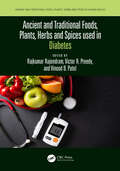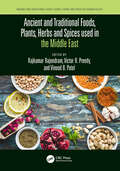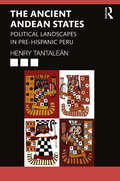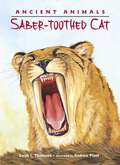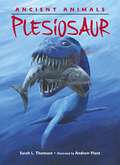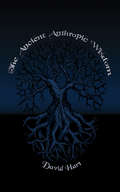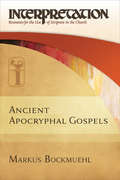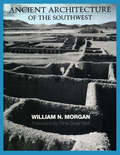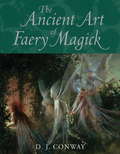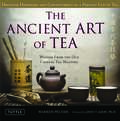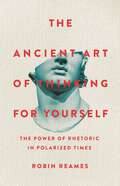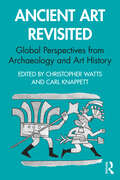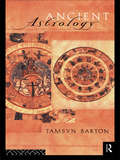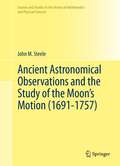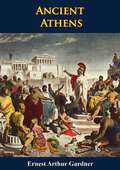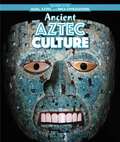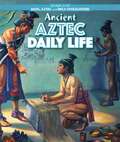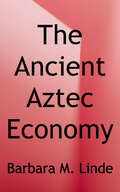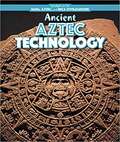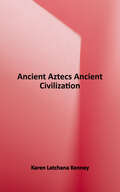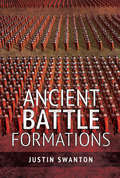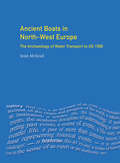- Table View
- List View
Ancient and Traditional Foods, Plants, Herbs and Spices used in Diabetes (Ancient and Traditional Foods, Plants, Herbs and Spices in Human Health)
by Rajkumar Rajendram Victor R. Preedy Vinood B. PatelThe use of different foods, herbs, and spices to treat or prevent disease has been recorded for thousands of years. Egyptian papyrus, hieroglyphics and ancient texts from the Middle East have described the cultivation and preparations of herbs and botanicals to “cure the sick.” There are even older records from China and India. Some ancient scripts describe the use of medicinal plants which have never been seen within European cultures. Indeed, all ancient civilizations have pictorial records of different foods, herbs, and spices being used for medical purposes. However, there are fundamental issues pertaining to the scientific evidence for the use of these agents or their extracts in modern medicine. These issues are explored in Ancient and Traditional Foods, Plants, Herbs and Spices Used in Diabetes. Features · Investigates alternative healthcare paradigms that use traditional dietary foods, plant-derived materials, and extracts to treat diabetes · Describes scientific studies using modern day biomedical techniques · Provides information on diets, specific agents, extracts and resources. · Many chapters focus on plant-derived material, providing a historical background, uses, toxicity, and cautionary notes and summary points. There have been considerable advances in scientific techniques over the last few decades. These have been used to examine the composition and applications of traditional cures. Modern science has also seen the investigation of herbs, spices and botanicals beyond their traditional usage. Diabetes is one of the most common diseases worldwide, with over 400 million people with the illness. With chapter contributions by an international panel of contributors, this book is useful for researchers in the area of functional foods. Diabetologists, nutritionists, endocrinologists, healthcare workers, and pharmacologists will also find this book extremely valuable.
Ancient and Traditional Foods, Plants, Herbs and Spices used in the Middle East (Ancient and Traditional Foods, Plants, Herbs and Spices in Human Health)
by Rajkumar Rajendram Victor R. Preedy Vinood B. PatelThe use of different foods, herbs, and spices to treat or prevent disease has been recorded for thousands of years. Egyptian papyrus, hieroglyphics and ancient texts from the Middle East have described the cultivation and preparations of herbs and botanicals to “cure the sick.” There are even older records from China and India. Some ancient scripts describe the use of medicinal plants which have never been seen within European cultures. Indeed, all ancient civilizations have pictorial records of different foods, herbs, and spices being used for medical purposes. However, there are fundamental questions and issues pertaining to the scientific evidence for the use of these agents or their extracts in modern medicine. These issues are explored in Ancient and Traditional Foods, Plants, Herbs and Spices used in the Middle East. Features · Describes uses and applications of plant-based materials from different countries of the Middle East. · Each chapter has unique cross references to foods, herbs, spices and botanicals · Bridges molecular biology, physiology and medical sciences · Coverage includes herbal medicines, supplements, lifestyle patterns, nutrition, and plant-based diets · Each chapter describes usage and applications of traditional foods and botanicals; historical background; toxicity; cautionary notes; and summary points There have been considerable advances in scientific techniques over the last few decades. These have been used to examine the composition and applications of traditional cures. Modern science has also seen the investigation of herbs, spices and botanicals beyond their traditional usage. Written by international experts, this is an essential read for food researchers, food scientists, and nutritionists, researchers and health professionals with an interest in the potential therapeutic value of Middle Eastern food components. The book will also be of relevance to physicians and pharmacologists.
The Ancient Andean States: Political Landscapes in Pre-Hispanic Peru
by Henry TantaleánThe Ancient Andean States combines modern social theory, recent archaeological literature and the experience of the author to examine politics and power in the great Andean prehispanic societies.
Ancient Animals: Saber-toothed Cat (Ancient Animals)
by Sarah L. ThomsonThe saber-toothed cat was a fearsome prehistoric predator. Written for beginning readers, clear and succinct text explains how we think saber-toothed cats lived, hunted and became extinct. Back matter explores other large-toothed predators and provides additional print, visual and web resources.
Ancient Animals: Plesiosaur (Ancient Animals)
by Sarah L. ThomsonNinety million years ago, giant dinosaurs roamed the earth, pterosaurs flew through the air, and giant reptiles and fish hunted in the oceans. The area that is now Kansas was covered by water and one of its inhabi-tants was the plesiosaur—a reptile with an extremely long neck and a huge body. This early reader about the ancient plesiosaur brings the prehistoric world of this ocean-dwelling animal to life, explain-ing how scientists think these reptiles lived, hunted, and became extinct. Back matter explores other reptiles both ancient and modern and provides additional print, visual, and web resources.
The Ancient Anthropic Wisdom
by David HartPart religious, part scientific study, The Ancient Anthropic Wisdom follows on from the Age of Aquarius - the Golden Age of Mankind, giving an insight into 'man' and his world as he never knew. Meditation tips, the hidden meaning of the Tree of Life, Solomon's Keys, Twin Souls and celestial guidance make for a truly fascinating read for everyone seeking answers to the mysteries of 'life' and 'man'.
Ancient Antioch
by De Giorgi, Andrea U.From late fourth century BC Seleucid enclave to capital of the Roman east, Antioch on the Orontes was one of the greatest cities of antiquity and served as a hinge between east and west. This book draws on a century of archaeological fieldwork to offer a new narrative of Antioch's origins and growth, as well as its resilience, civic pride, and economic opportunism. Situating the urban nucleus in the context of the rural landscape, this book integrates hitherto divorced cultural basins, including the Amuq Valley and the Massif Calcaire. It also brings into focus the archaeological data, thus proposing a concrete interpretative framework that, grounded in the monuments of Antioch, enables the reader to move beyond text-based reconstructions of the city's history. Finally, it considers the interaction between the environment and the people of the city who shaped this region and forged a distinct identity within the broader Greco-Roman world.
Ancient Apocryphal Gospels
by Markus BockmuehlIn this reader-friendly guide, Markus Bockmuehl offers a sympathetic account of the ancient apocryphal Gospel writings, showing their place within the reception history and formation of what was to become the canonical fourfold Gospel. Bockmuehl begins by helping readers understand the early history behind these noncanonical Gospels before going on to examine dozens of specific apocryphal texts. He explores the complex oral and intertextual relationships between the noncanonical and canonical Gospels, maintaining that it is legitimate and instructive to read the apocryphal writings as an engagement with the person of Jesus that both presupposes and supplements the canonical narrative outline. Appropriate for pastors and nonspecialists, this work offers a fuller understanding of these writings and their significance for biblical interpretation in the church.
Ancient Architecture of the Southwest
by William N. Morgan<p>During more than a thousand years before Europeans arrived in 1540, the native peoples of what is now the southwestern United States and northern Mexico developed an architecture of rich diversity and beauty. Vestiges of thousands of these dwellings and villages still remain, in locations ranging from Colorado in the north to Chihuahua in the south and from Nevada in the west to eastern New Mexico—a geographical area of some 300,000 square miles. This study presents a comprehensive architectural survey of the region. Professionally rendered drawings comparatively analyze 132 sites by means of standardized 100-foot grids with uniform orientations. Reconstructed plans with shadows representing vertical heights suggest the original appearances of many structures that are now in ruins or no longer exist, while concise texts place them in context.<p> <p>Organized in five chronological sections that include 132 professionally rendered site drawings, the book examines architectural evolution from humble pit houses to sophisticated, multistory pueblos. The sections explore concurrent Mogollon, Hohokam, and Anasazi developments, as well as those in the Salado, Sinagua, Virgin River, Kayenta, and other areas, and compare their architecture to contemporary developments in parts of eastern North America and Mesoamerica. The book concludes with a discussion of changes in Native American architecture in response to European influences. Written for a general audience, the book holds appeal for all students of native Southwestern cultures, as well as for everyone interested in origins in architecture. In particular, it should encourage younger Native American architects to value their rich cultural heritage and to respond as creatively to the challenges of the future as their ancestors did to those of the past.<p>
Ancient Architecture of the Southwest
by William N. MorganDuring more than a thousand years before Europeans arrived in 1540, the native peoples of what is now the southwestern United States and northern Mexico developed an architecture of rich diversity and beauty. Vestiges of thousands of these dwellings and villages still remain, in locations ranging from Colorado in the north to Chihuahua in the south and from Nevada in the west to eastern New Mexico--a geographical area of some 300,000 square miles. This study presents a comprehensive architectural survey of the region. Professionally rendered drawings comparatively analyze 132 sites by means of standardized 100-foot grids with uniform orientations. Reconstructed plans with shadows representing vertical heights suggest the original appearances of many structures that are now in ruins or no longer exist, while concise texts place them in context. Organized in five chronological sections that include 132 professionally rendered site drawings, the book examines architectural evolution from humble pit houses to sophisticated, multistory pueblos. The sections explore concurrent Mogollon, Hohokam, and Anasazi developments, as well as those in the Salado, Sinagua, Virgin River, Kayenta, and other areas, and compare their architecture to contemporary developments in parts of eastern North America and Mesoamerica. The book concludes with a discussion of changes in Native American architecture in response to European influences. Written for a general audience, the book holds appeal for all students of native Southwestern cultures, as well as for everyone interested in origins in architecture. In particular, it should encourage younger Native American architects to value their rich cultural heritage and to respond as creatively to the challenges of the future as their ancestors did to those of the past. During more than a thousand years before Europeans arrived in 1540, the native peoples of what is now the southwestern United States and northern Mexico developed an architecture of rich diversity and beauty. Vestiges of thousands of these dwellings and villages still remain, in locations ranging from Colorado in the north to Chihuahua in the south and from Nevada in the west to eastern New Mexico. This study presents the most comprehensive architectural survey of the region currently available. Organized in five chronological sections that include 132 professionally rendered site drawings, the book examines architectural evolution from humble pit houses to sophisticated, multistory pueblos. The sections explore concurrent Mogollon, Hohokam, and Anasazi developments, as well as those in the Salado, Sinagua, Virgin River, Kayenta, and other areas, and compare their architecture to contemporary developments in parts of eastern North America and Mesoamerica. The book concludes with a discussion of changes in Native American architecture in response to European influences.
The Ancient Art of Faery Magick
by D. J. Conway- A thorough introduction to faeries, including history, lore, and spells for making contact with these magickal creatures. - Followers of Celtic, Faery, Dianic, and Nordic traditions will all find an abundance of knowledge valuable to their beliefs. - Details faeries of the home, earth, air, fire, water, plants, forests, mountains, and deserts.
The Ancient art of Tea
by John T. Kirby Warren Peltier"It is my hope that this book will encourage others in the West to pick up where the ancients and the author left off and go out and search for sources of sweet water here in North America. ... It is time for us to pick up the mantle and spread the word, Tea."--Dr. Eric Messersmith, Institute for Asian Studies, Florida International UniversityThe health benefits of tea, from green teas to white, oolong and black teas, are well known in our world today. How to create the perfect, healthy cup of tea is a process few people truly understand, making The Ancient Art of Tea a needed guide for tea lovers.Making a perfect cup of tea is a dynamic process that requires the right environment, good spring water, a suitable fire to boil water, skill in steeping tea, and deep understanding of tea connoisseurship. The Ancient Art of Tea teaches the two fundamental secrets to tea as practiced in ancient China--technique and taste. With this beautiful volume, you will be able to enhance and thoroughly immerse yourself in the tea experience.
The Ancient Art of Thinking For Yourself: The Power of Rhetoric in Polarized Times
by Robin ReamesHow rhetoric—the art of persuasion—can help us navigate an age of misinformation, conspiracy theories, and political acrimony The discipline of rhetoric was the keystone of Western education for over two thousand years. Only recently has its perceived importance faded. In this book, renowned rhetorical scholar Robin Reames argues that, in today&’s polarized political climate, we should all care deeply about learning rhetoric. Drawing on examples ranging from the destructive ancient Greek demagogue Alcibiades to modern-day conspiracists like Alex Jones, Reames breaks down the major techniques of rhetoric, pulling back the curtain on how politicians, journalists, and &“journalists&” convince us to believe what we believe—and to talk, vote, and act accordingly. Understanding these techniques helps us avoid being manipulated by authority figures who don&’t have our best interests at heart. It also grants us rare insight into the values that shape our own beliefs. Learning rhetoric, Reames argues, doesn&’t teach us what to think but how to think—allowing us to understand our own and others&’ ideological commitments in a completely new way. Thoughtful, nuanced, and leavened with dry humor, The Ancient Art of Thinking for Yourself offers an antidote to our polarized, post-truth world.
Ancient Art Revisited: Global Perspectives from Archaeology and Art History
by Christopher Watts Carl KnappettAncient Art Revisited develops new perspectives on ancient art by weaving together diverse strands within archaeology and art history, exploring it through recent developments in archaeological theory. In order to foster dialogue among various subfields, contributors are drawn from a wide range of domains. Classical archaeology, Aegean prehistory, Near Eastern archaeology, Egyptology, Pre-Columbian South America, and North America are brought together to explore ancient art from multiscalar perspectives and through the lenses of entanglement theory, network thinking, assemblage theory, and other recent theoretical developments. Representing a new wave in research on ancient art, considering both the proximal and distributed operations of artworks, Ancient Art Revisited provides broad and inclusive coverage of ancient art and offers a cohesive approach to a fragmented area of study. This book will be suitable for archaeologists, anthropologists, and art historians wishing to understand the latest thinking on ancient art.
Ancient Astrology (Sciences of Antiquity)
by Tamysn BartonAn account of astrology from its beginnings in Mesopotamia, focusing on the Greco-Roman world, Ancient Astrology examines the theoretical development and changing social and political role of astrology.
Ancient Astronomical Observations and the Study of the Moon’s Motion (Sources and Studies in the History of Mathematics and Physical Sciences)
by John M. SteeleThe discovery of a gradual acceleration in the moon's mean motion by Edmond Halley in the last decade of the seventeenth century led to a revival of interest in reports of astronomical observations from antiquity. These observations provided the only means to study the moon's 'secular acceleration', as this newly-discovered acceleration became known. This book contains the first detailed study of the use of ancient and medieval astronomical observations in order to investigate the moon's secular acceleration from its discovery by Halley to the establishment of the magnitude of the acceleration by Richard Dunthorne, Tobias Mayer and Jérôme Lalande in the 1740s and 1750s. Making extensive use of previously unstudied manuscripts, this work shows how different astronomers used the same small body of preserved ancient observations in different ways in their work on the secular acceleration. In addition, this work looks at the wider context of the study of the moon's secular acceleration, including its use in debates of biblical chronology, whether the heavens were made up of æther, and the use of astronomy in determining geographical longitude. It also discusses wider issues of the perceptions and knowledge of ancient and medieval astronomy in the early-modern period. This book will be of interest to historians of astronomy, astronomers and historians of the ancient world.
Ancient Athens
by Ernest Arthur GardnerAn archaeological & topological study of the ancient city, richly illustrated with plans, maps and drawings throughout.“What I would prefer is that you should fix your eyes every day on the greatness of Athens as she really is, and should fall in love with her. When you realize her greatness, then reflect that what made her great was men with a spirit of adventure, men who knew their duty, men who were ashamed to fall below a certain standard. If they ever failed in an enterprise, they made up their minds that at any rate the city should not find their courage lacking to her, and they gave to her the best contribution that they could.” – The Funeral Oration of Pericles, quoted by Thucydides.Ernest Arthur Gardner (16 March 1862 – 27 November 1939) was an English archaeologist. He was the director of the British School at Athens between 1887 and 1895.
Ancient Aztec Culture (Spotlight on the Maya, Aztec, and Inca Civilizations Series)
by Emily Jankowski MahoneyThe ancient Aztec people had a complex and fascinating culture with their own religious rituals, ceremonies, and art. <p><p>Readers explore the details of Aztec culture through informative text designed to reflect social studies curriculum topics. Full-color photographs and historical images allow readers to immerse themselves in this unique culture. <p><p>Carefully chosen primary sources are included to provide a direct link between past and present. Did the Aztec people really perform human sacrifices? Readers will find out when they explore the incredible world of ancient Aztec culture.
Ancient Aztec Daily Life (Spotlight On The Maya, Aztec, And Inca Civilizations Ser.)
by Heather Moore NiverThe ancient Aztec people didn’t have grocery stores or shopping malls. How did they get their food? What was their clothing like? Readers discover the answers to these questions and many more as they explore the lives of the ancient Aztec people. The detailed main text provides an informative look at Aztec daily life, allowing readers to compare their life in the present to life as a member of the Aztec civilization. Full-color photographs and historical images accompany the text, helping readers visualize these essential social studies curriculum topics. Readers gain additional information from carefully chosen primary sources.
The Ancient Aztec Economy (Spotlight on the Maya, Aztec, and Inca Civilizations Series)
by Barbara M. LindeWhen most people think of the word "economy," they think of stock markets and modern banks. However, even ancient civilizations had their own economies. Readers discover fun and fascinating facts about the ancient Aztec economy through informative text designed to support social studies curricula. Detailed photographs and historical images, such as primary sources, are included to enhance the text and keep readers engaged as they learn. <p><p>Economics and history come together in an amazing way to ensure readers gain a comprehensive understanding of the ancient Aztec economy.
Ancient Aztec Technology (Spotlight On The Maya, Aztec, And Inca Civilizations Ser.)
by Emily Jankowski MahoneyTechnology is guiding force in all civilizations. Readers discover the role technology played in ancient Aztec life through text designed to reflect essential social studies curriculum topics. Accessible text introduces readers to the technology used by ancient Aztecs, helping them make their own comparisons to the technology available to us today. Colorful photographs and historical images bring readers into the world of the ancient Aztec people. Primary sources are also included to enhance readers’ learning experience. What did the Aztec people use to make their tools and weapons? Readers will have fun finding out.
Ancient Aztecs (Ancient Civilizations)
by Karen Latchana KenneyThe legacy of past civilizations is still with us today. In Ancient Aztecs, readers discover the history and impressive accomplishments of the Aztec civilization, including their military power and feats of engineering. The engaging text provides details on the civilization's history, development, daily life, culture, art, technology, warfare, social organization, and more. Well-chosen maps and images of artifacts bring the past to life. Aligned to Common Core Standards and correlated to state standards. Essential Library is an imprint of Abdo Publishing, a division of ABDO.
Ancient Battle Formations
by Justin SwantonAn analysis of ancient Greek, Roman, and Macedonian winning battle formations, from why they worked, the equipment and men used, and how they broke down. Justin Swanton examines the principal battle-winning formations of the ancient world, determining their composition, function and efficacy. An introductory chapter looks at the fundamental components of the principal battle formations of heavy and light infantry, cavalry, elephants and chariots, showing how they bolstered the individual's soldier's willingness to fight. The rest of the book focuses on massed infantry that reigned supreme in this era: the heavily armored Greek hoplite phalanx that was immune to the weaponry of its non-Greek opponents; the Macedonian pike phalanx that was unbeatable against frontal attacks so long as it kept order; the Roman triplex acies which, contrary to popular opinion, consisted of continuous lines in open order, with file spaces wide enough to allow embattled infantry to fall back after which those files closed up instantly against the enemy. A careful study of the Greek and Latin of the sources sheds fresh light on how these formations were organized and worked, reevaluating many conventional notions and leading to some surprising conclusions.Praise for Ancient Battle Formations&“This book is both important for its thoroughly researched, original and well-argued historical conclusions and an enjoyable read. Highly recommended.&” —Professor F. Noel Zaal (BA, LLB University of Natal, LLM Durban-Westville, LLM Columbia, PhD Wits
Ancient Battle Formations
by Justin SwantonAn analysis of ancient Greek, Roman, and Macedonian winning battle formations, from why they worked, the equipment and men used, and how they broke down.Justin Swanton examines the principal battle-winning formations of the ancient world, determining their composition, function and efficacy. An introductory chapter looks at the fundamental components of the principal battle formations of heavy and light infantry, cavalry, elephants and chariots, showing how they bolstered the individual's soldier's willingness to fight.The rest of the book focuses on massed infantry that reigned supreme in this era: the heavily armored Greek hoplite phalanx that was immune to the weaponry of its non-Greek opponents; the Macedonian pike phalanx that was unbeatable against frontal attacks so long as it kept order; the Roman triplex acies which, contrary to popular opinion, consisted of continuous lines in open order, with file spaces wide enough to allow embattled infantry to fall back after which those files closed up instantly against the enemy.A careful study of the Greek and Latin of the sources sheds fresh light on how these formations were organized and worked, reevaluating many conventional notions and leading to some surprising conclusions.Praise for Ancient Battle Formations“This book is both important for its thoroughly researched, original and well-argued historical conclusions and an enjoyable read. Highly recommended.” —Professor F. Noel Zaal (BA, LLB University of Natal, LLM Durban-Westville, LLM Columbia, PhD Wits
Ancient Boats in North-West Europe: The Archaeology of Water Transport to AD 1500
by Sean McgrailAt last a paperback edition of this standard work on marine archaeology. Séan McGrail's study received exceptional critical acclaim when it was first published in hardback in 1987 and it is now revised and published in paperback for the first time. Professor McGrail provides an authoritative survey of water transport across Northern Europe from the Late Palaeolithic to the later Middle Ages, using evidence of excavations, but also documentary sources, iconographic and ethnographic evidence. In the process he answers such key questions as How were these boats built? What sort of environment were they used in? What speeds could they achieve? and how were they navigated?
